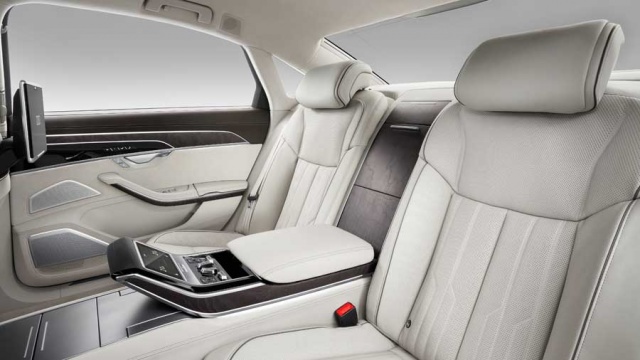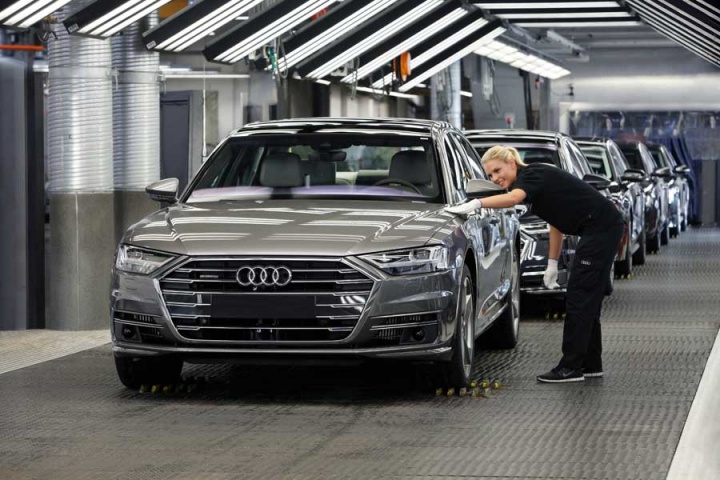What's the news?
Audi has pulled the covers off the all-new A8, its flagship saloon, and outlined the future direction for the company in both design and technology. It retains a familiar, but modernised, Audi saloon style, but underneath lies a thoroughly advanced car that offers driver assistance systems up to Level 3 autonomy. Naturally, it also can provide all of the luxuries one could desire in such a car including some that you may not have thought were possible.
Exterior
The new A8 draws heavily from the Audi Prologue design studies that debuted as a series of concept cars back in 2015. It looks significantly sharper than the outgoing A8, but whether Audi has done enough to evolve the design is debatable. Its front is more upright and features a large single frame grille that is flanked by much sharper looking LED headlights using Audi's HD Matrix system with laser lighting.
Overall length measures in at 5,172mm for the standard A8, an increase of 37mm over its predecessor, while the long-wheelbase A8 L adds another 130mm to the length. It is 4mm narrower than the outgoing model, but 13mm taller (and 17mm taller for the A8 L), while the wheelbase in both lengths grows by a modest 6mm.
The lighting on the rear of the car now employs OLED technology that, in addition to providing the necessary functions, adds a detailed lighting signature that is capable of producing animations as the driver approaches or leaves the car.
Interior
The new Audi A8 is a car that you won't be in too much of a rush to get out of given the level of detail and luxury that the German company has extended to its flagship saloon. It is where classic and elegant styling meets the latest in technology, with buttons virtually eliminated. Air vents are incorporated into a wraparound section in the dashboard and are concealed by shutters when inactive. Beneath is a new 10.1-inch touchscreen display surrounded by high gloss black trim. A second 8.6-inch touchscreen display is located further down on the centre console. Directly in front of the driver, Audi continues to use its 12.3-inch TFT monitor in place of the traditional dashboard instruments and this is fed by a separate NVIDIA K1 computer. There is an optional head-up display that is capable of relaying important driving data to the driver's line of sight and appears to float above the end of the bonnet at a distance of 2.3 metres ahead of the car.
Audi is continuing its use of high-quality materials throughout the cabin of the A8, offering eight material and colour schemes. As well as detailed stitching and a range of wood finishes ranging from beech and eucalyptus to burr walnut, the cabin is draped in ambient light schemes at night. Audi will offer its Exclusive Program for the A8 for discerning buyers to specify something more unique.
If you're lucky enough to be sitting in the rear of the A8, especially the long-wheelbase version, you're in for a treat. Audi offers what it calls a relaxation seat in the back that is akin to what you might expect to find in the first class cabin of a plane. As well as the expected electrically adjustable reclining seat, a special surface in the backrest of the seat in front provides the option of warming and massaging the rear occupant's feet with a number of different programmes from which to choose. The main seat can also provide its passenger with full-surface reflexology along with seat ventilation.
Mechanicals
All of the engine variants in the A8 model range will feature some kind of hybridisation, ranging from a mild hybrid system that enables coasting with the engine off to an e-tron version capable of longer electric-only driving. Both types utilise a 48-volt electrical system. With the Mild Hybrid Electric Vehicle (MHEV), a smaller on-board lithium-ion battery in the boot space can provide power for the car's ancillary systems for short periods of time with the engine shut off. This battery enables the A8 to coast silently from 55- to 160km/h with the engine off for up to 40 seconds, working like an extended start-stop system, but on the move. Once the driver touches the throttle, the engine restarts. The transition is claimed to be very smooth thanks to the use of a belt alternator starter.
Initially, Audi will offer the A8 with the choice of a 286hp 3.0-litre V6 TDI diesel engine or 340hp 3.0-litre V6 TFSI petrol, both of which will be equipped with an eight-speed automatic transmission. This has its gearshift process specially modified for re-engagement after engine-off coasting. Audi's all-wheel-drive quattro system will feature across the range too. Following the launch, Audi will increase the A8's engine offering by adding diesel and petrol turbocharged 4.0-litre V8 engines producing 435- and 460hp respectively. There's good news for plutocrats also, as Audi will continue to offer a W12 engine with 585hp.
There will also be an A8 L e-tron version with a combined system power output of 449hp, capable of electric-only driving of up to 50 kilometres. Audi is also making wireless inductive charging available at a rate of 3.6kW as standard.
Audi's technological tour de force continues throughout the rest of the car where a number of new features and systems are designed to increase both the agility and comfort of the A8. Adaptive air suspension is linked to the three drive select modes and changes accordingly. At 120km/h the body automatically lowers by 20mm to improve the aerodynamics.
One of the new aspects of the suspension is the option of what Audi calls its AI Active Suspension. It will be available on the V6 TFSI and both V8 engines as an option, and standard on the W12. It is an electromechanically operated suspension system that can increase or reduce load on each wheel individually. This action is performed via a transmission, a rotary tube housing a titanium roll bar and a lever that is capable of exerting up to 1,100Nm on the suspension via a coupling rod. The result is greater levels of flexibility according to the chosen drive mode, ranging from buttery smooth to firm where roll angles can be halved according to Audi.
The system has one other neat safety feature. If the Pre Sense 360 system detects an impending lateral impact at speeds of over 25km/h, actuators in the suspension raise the body on the side that is exposed to the danger by 80mm within half a second. The sudden movement results in the lower sill and floor of the car taking a greater proportion of the impact and improving the dissipation of the impact.
Anything else?
One of the crowning tech features of the A8 is Audi's AI system that enables Level 3 automated driving. Whereas Level 2 systems require the driver to monitor the situation continuously, this increased level of automation means that the driver must only be capable of taking back control when the system prompts them.
Traffic Jam Pilot is activated by pressing the AI button on the centre console and in particular situations below 60km/h in nose-to-tail traffic where there is a physical barrier separating two carriageways, such as on a motorway, the car can control steering, braking, accelerating and starting from a stopped position. In this scenario, the driver does not need to hold the steering wheel or touch the pedals.
The A8 features a wide array of sensors to gain a very accurate picture of what is going on around it at all times. These are made up of four 360-degree cameras on the front, rear and side mirrors, four mid-range radars at each corner, one long-range radar in the front, a front-mounted laser scanner, an infrared camera and 12 ultrasonic sensors dotted around the car.
In the case of highly automated driving, the car has a small camera that can detect if the driver is tiring or has fallen asleep. Multi-stage warnings play, and the driver is prompted to retake control. If the driver does not respond the car will automatically come to a standstill. This system will be rolled out over time and in accordance with the approval procedures for individual countries.
Other elements of the AI system are the Remote Parking Pilot and Garage Pilot. The first sees the car parallel or right-angle park into a space without the driver being inside the car. The parking process is initiated via the Audi AI button in the smartphone app. The car sees the space and does all the driving, steering and braking needed to manoeuvre itself into the parking space. Once parked it will engage Park and switch off the engine and ignition.
Garage Pilot turns the A8 into a large luxurious remote controlled car to help you squeeze it into a garage space. The system is similar to that offered on the BMW 7 Series but seems to operate at a more advanced level, with more steering angle and makes use of the laser scanner to ensure that is can move very close to walls and other typical garage obstructions without touching them.


